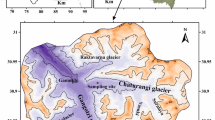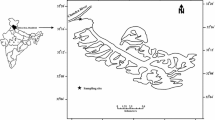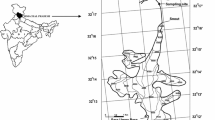Abstract
This manuscript discusses about the solute acquisition processes controlling hydrogeochemistry and suspended sediment characteristics of meltwater of the Batal glacier, Western Himalaya, India. The predominance of anions and cations in meltwater follows the order: SO4 2− > HCO3 − > Cl− > NO3 − and Ca2+> Mg2+> Na+> K+, respectively. High excess of (Ca + Mg) over (Na + K), high input of (Ca + Mg) to the TZ+ (total cations) and very low input of (Na + K) to the total cations (TZ+) demonstrate that meltwater chemistry of Batal glacier is predominantly regulated by carbonate type weathering along with minor input from silicate type weathering. Sulphide oxidation is the dominant mechanism responsible for delivery of hydrogen ions (protons) for weathering in the glacier environment, which is revealed by C-ratio of meltwater. The Piper trilinear plot indicates that Ca–SO4 is the prevalent water type in the study area with dominancy of (Ca + Mg) (alkaline earth metals) over (Na + K) (alkali metals) and dominancy of (SO4 + Cl) (strong acid) over (HCO3) (weak acid). Interrelation among the different chemical constituents of meltwater and various factor regulating meltwater chemistry of the Batal glacier are evaluated by multivariate statistical analysis. Average suspended sediment concentrations in meltwater of the study area for August and September 2014 were computed to be 706 and 98.3 mg/l, respectively. These results show that in August suspended sediment concentrations is high and in September its concentration is low.






Similar content being viewed by others
References
Raina VK (2009) Himalayan glaciers: a state-of-art review of glacial studies, glacial retreat and climate change. MoEF discussion paper, ministry of environment and forests, Government of India/GB Pant Institute of Himalayan Environment and Development, New Delhi
Tiwari RK, Gupta RP, Arora MK (2014) Estimation of surface ice velocity of Chhota-Shigri glacier using sub-pixel ASTER image correlation. Curr Sci 106(6):853–859
Haeberli W (2008) Changing views of changing glaciers. In: Orlove B, Wiegandt E, Luckman BH (eds) Darkening peaks: glacier retreat, science, and society. University of California Press, Berkeley, pp 23–32
Owen LA, Derbyshire E, Richardson S, Benn DI, Evans DJA, Mitchell WA (1996) The quaternary glacial history of the Lahul Himalaya, northern India. J Quat Sci 11(1):25–42
GSI (Geological Survey of India) (1999) Inventory of the Himalayan glaciers. In: Kaul MK (ed) A contribution to the international hydrological program. Geological Survey of India, special publication number 34, p 165
Immerzeel WW, van Beeke LPH, Bierkens MFP (2010) Climate change will affect the Asian water towers. Science 328:1382–1385
Bhutiyani MR, Kale VS, Pawar NJ (2007) Long-term trends in maximum, minimum and mean annual air temperatures across the northwestern Himalaya during the twentieth century. Clim Change 85:159–177
Tranter M, Brown GH, Raiswell R, Sharp MJ, Gurnell AM (1993) A conceptual model of solute acquisition by Alpine glacier meltwaters. J Glaciol 39(133):573–581
Tranter M, Brown GH, Hodson AJ, Gurnell AM (1996) Hydrochemistry as an indicator of subglacial drainage system structure: a comparison of alpine and sub-polar environments. Hydrol Proc 10:541–556
Singh AK, Hasnain SI (1998) Major ion chemistry and weathering control in a high altitude basin: Alaknanda river, Garhwal Himalaya, India. Hydrol Sci J 43(6):825–843
Fairchild IJ, Killawee JA, Sharp MJ, Spiro B, Hubbard B, Lorrain RD, Tison JL (1999) Solute generation and transfer from a chemically reactive alpine glacier-proglacial system. Earth Surf Process Landf 24:1189–1211
Hasnain SI, Subramanian V, Dhanpal K (1989) Chemical characteristics and suspended sediment load of meltwaters from a Himalayan Glacier in India. J Hydrol 106:99–108
Singh VB, Ramanathan AL, Sharma P, Pottakkal JG (2015) Dissolved ion chemistry and suspended sediment characteristics of meltwater draining from Chhota Shigri Glacier, western Himalaya, India. Arab J Geosci 8:281–293
Singh VB, Ramanathan AL, Sharma P (2015) Major ion chemistry and assessment of weathering processes of the Patsio glacier meltwater, Western Himalaya, India. Environ Earth Sci 73:387–397
Singh VB, Ramanathan AL, Kuriakose T (2015) Hydrogeochemical assessment of meltwater quality using major ion chemistry: a case study of Bara Shigri Glacier, western Himalaya, India. Natl Acad Sci Lett 38(2):147–151
Singh VB, Ramanathan AL (2015) Assessment of solute and suspended sediment acquisition processes in the Bara Shigri glacier meltwater (Western Himalaya, India). Environ Earth Sci 74:2009–2018
Sharma P, Ramanathan AL, Pottakkal JG (2013) Study of solute sources and evolution of hydrogeochemical processes of the Chhota Shigri Glacier meltwaters, Himachal Pradesh, India. Hydrol Sci J 58(5):1128–1143
Singh SK, Rathore BP, Bahuguna IM, Ramanathan AL, Ajai (2012) Estimation of glacier ice thickness using Ground Penetrating Radar in the Himalayan region. Curr Sci 103(1):68–73
Kumar S, Rai H, Purohit KK, Rawat BRS, Mundepi AK (1987) Multi disciplinary glacier expedition to Chhota Shigri glacier. Department of Science and Technology, Government of India, New Delhi, Technical report number 1, pp 1–29
APHA (2005) Standard methods for examination of water and wastewater, 21st edn. American Public Health Association, Washington
Das BK, Kaur P (2001) Major ion chemistry of Renuka Lake and weathering processes, Simaur District, Himachal Pradesh, India. Environ Geol 40:908–917
Hren MT, Chamberlain CP, Hilley GE, Blisniuk PM, Bookhagen B (2007) Major ion chemistry of the Yarlung Tsangpo–Brahmaputra river: chemical weathering, erosion, and CO2 consumption in the southern Tibetan plateau and eastern syntaxis of the Himalaya. Geochim Cosmochim Acta 71:2907–2935
Brown GH, Tranter M, Sharp M (1996) Subglacial chemical erosion-seasonal variations in solute provenance, Haut Glacier d’Arolla, Switzerland. Ann Glaciol 22:25–31
Nijampurkar VN, Sarin MM, Rao DK (1993) Chemical composition of snow and ice from Chhota Shigri glacier, Central Himalaya. J Hydrol 151:19–34
Souchez RA, Lemmens MM (1987) Solutes. In: Gurnell AM, Clark MJ (eds) Glacio-fluvial sediment transfer. Wiley, Chichester, pp 285–303
Meybeck M (1983) Atmospheric inputs and river transport of dissolved substances. In: Webb BW (ed) Dissolved loads of rivers and surface water quality/quantity relationships, IAHS publication number 141, pp 173–191
Ramkumar T, Venkatramanan S, Anithamary I, Ibrahim SMS (2013) Evaluation of hydrogeochemical parameters and quality assessment of the groundwater in Kottur blocks, Tiruvarur district, Tamilnadu, India. Arab J Geosci 6:101–108
Sikdar PK, Sarkar SS, Palchoudhury S (2001) Geochemical evaluation of groundwater in the Quaternary aquifer of Calcutta and Howrah, India. J Asian Earth Sci 19:579–594
Piper AM (1944) A graphical procedure in the geochemical interpretation of water analysis. Trans Am Geophys Union 25:914–923
Hoyle BL (1989) Groundwater quality variations in a silty alluvial soil aquifer, Oklahoma. Ground Water 27:540–549
Zhu B, Yu J, Qin X, Rioual P, Liu Z, Zhang Y, Jiang F, Mu Y, Li H, Ren X, Xiong H (2013) The significance of mid-latitude rivers for weathering rates and chemical fluxes: evidence from northern Xinjiang rivers. J Hydrol 486:151–174
Sharp MJ (1991) Hydrological inferences from meltwater quality data-the unfulfilled potential. In: Proc. BHS 3rd national hydrological symposium, Southampton, pp 5.1–5.8
Wadham JL, Hodson AJ, Tranter M, Dowdeswell JA (1998) The hydrochemistry of meltwater draining a polythermal-based, high Arctic glacier, south Svalbard I: the ablation season. Hydrol Proc 12:1825–1849
Panigrahy BK, Raymahashay BC (2005) River water quality in weathered limestone: a case study in upper Mahanadi basin, India. J Earth Syst Sci 114:533–543
Anshumali Rani M, Yadav SK, Kumar A (2014) Geochemical alterations in surface waters of Govind Ballabh Pant Sagar, Northern Coalfield, India. Environ Earth Sci 71:3181–3193
Ahmad S, Hasnain SI (2001) Chemical characteristics of stream draining from Dudu glacier: an Alpine meltwater stream in Ganga Headwater, Garhwal Himalaya. J China Univ Geosci 12(1):75–83
Singh VB, Ramanathan AL, Pottakkal JG, Sharma P, Linda A, Azam MF, Chatterjee C (2012) Chemical characterisation of meltwater draining from Gangotri Glacier, Garhwal Himalaya, India. J Earth Syst Sci 121(3):625–636
Tay CK (2012) Hydrochemistry of groundwater in the Savelugu–Nanton District, Northern Ghana. Environ Earth Sci 67:2077–2087
Nair A, Abdalla G, Mehmed I, Premkumar K (2005) Physicochemical parameters and correlation coefficient of groundwaters of north-east Libiya. Pollut Res 24(1):1–6
Wold S, Esbensen K, Geladi P (1987) Principal component analysis. Chemom Intell Lab Syst 2(1):37–52
Farnham IM, Johannesson KH, Singh AK, Hodge VF, Stetzenbach KJ (2003) Factor analytical approaches for evaluating groundwater trace element chemistry data. Anal Chim Acta 490:123–138
Boruvka L, Vecek O, Jehlicka J (2005) Principal component analysis as a tool to indicate the origin of potentially toxic elements in soil. Geoderma 128:289–300
Singh VB, Ramanathan AL, Pottakkal JG, Kumar M (2014) Seasonal variation of the solute and suspended sediment load in Gangotri glacier meltwater, central Himalaya, India. J Asian Earth Sci 79:224–234
Collins DN (1998) Suspended sediment flux in meltwaters draining from Batura glacier as an indicator of the rate of glacial erosion in the Karakoram mountains. Quat Proc 6:1–10
Pandey SK, Singh AK, Hasnain SI (2002) Grain-size distribution, morphoscopy and elemental chemistry of suspended sediments of Pindari Glacier, Kumaon Himalaya, India. Hydrol Sci J 47(2):213–226
Wills IC, Richarda KS, Sharp MJ (1996) links between proglacial stream suspended sediment dynamics, glacier hydrology and glacier motion at midtdalsbreen, Norway. Hydrol Proc 10:629–648
Pandey SK, Singh AK, Hasnain SI (1999) Weathering and geochemical processes controlling solute acquisition in Ganga Headwater–Bhagirathi River, Garhwal Himalaya, India. Aquat Geochem 5(4):357–379
Haritashya UK, Singh P, Kumar N, Gupta RP (2006) Suspended sediment from the Gangotri Glacier: quantification, variability and associations with discharge and air temperature. J Hydrol 321:116–130
Ostrem G (1975) Sediment transport in glacial meltwater stream. In: Jopling AV, McDonald BC (ed) Glacio-fluvial and glaciolacustrine sedimentation. Society of economic palaeontologists and mineralogists. Special publication number 23, pp 101–122
Collins DN (1990) Seasonal and annual variations of suspended sediment transport in meltwaters draining from an Alpine glacier. In: Proceeding of two Lausanne symposium, IAHS publication number 193, pp 439–446
Singh AK, Pandey SK, Panda S (1998) Dissolved and sediment load characteristics of Kafni glacier meltwater, Pindar valley, Kumaon Himalaya. J Geol Soc India 52:305–312
Ahmad S, Hasnain SI (2000) Meltwater characteristics of Garhwal Himalayan glaciers. J Geol Soc India 56:431–439
Singh VB, Ramanathan AL, Pottakkal JG, Kumar M (2015) Hydrogeochemistry of meltwater of the Chaturangi Glacier, Garhwal Himalaya, India. Proc Natl Acad Sci India Sect A Phys Sci 85(1):187–195
Sharma BM, Tayal S, Chakraborty P, Bharat GK (2015) Chemical characterization of meltwater from East Rathong glacier vis-à-vis Western Himalayan Glaciers. In: Joshi R, Kumar K, Palni LMS (eds) Dynamics of climate change and water resources of Northwestern Himalaya. Springer, Switzerland, pp 181–190
Acknowledgments
We warmly thank to Department of Sciences and Technology, Government of India for pecuniary help to carry out this research. We are thankful to Dr. Vikas Kamal for his contribution in the preparation of map of the study area. The authors are also grateful to Dr. Parmanand Sharma for his valuable information regarding Batal glacier. Jawaharlal Nehru University, New Delhi is also acknowledged for providing research facilities.
Author information
Authors and Affiliations
Corresponding author
Ethics declarations
Conflict of interest
The authors declare that they have no conflict of interest.
Rights and permissions
About this article
Cite this article
Singh, V.B., Ramanathan, A. Characterization of Hydrogeochemical Processes Controlling Major Ion Chemistry of the Batal Glacier Meltwater, Chandra Basin, Himachal Pradesh, India. Proc. Natl. Acad. Sci., India, Sect. A Phys. Sci. 87, 145–153 (2017). https://doi.org/10.1007/s40010-016-0294-9
Received:
Revised:
Accepted:
Published:
Issue Date:
DOI: https://doi.org/10.1007/s40010-016-0294-9




